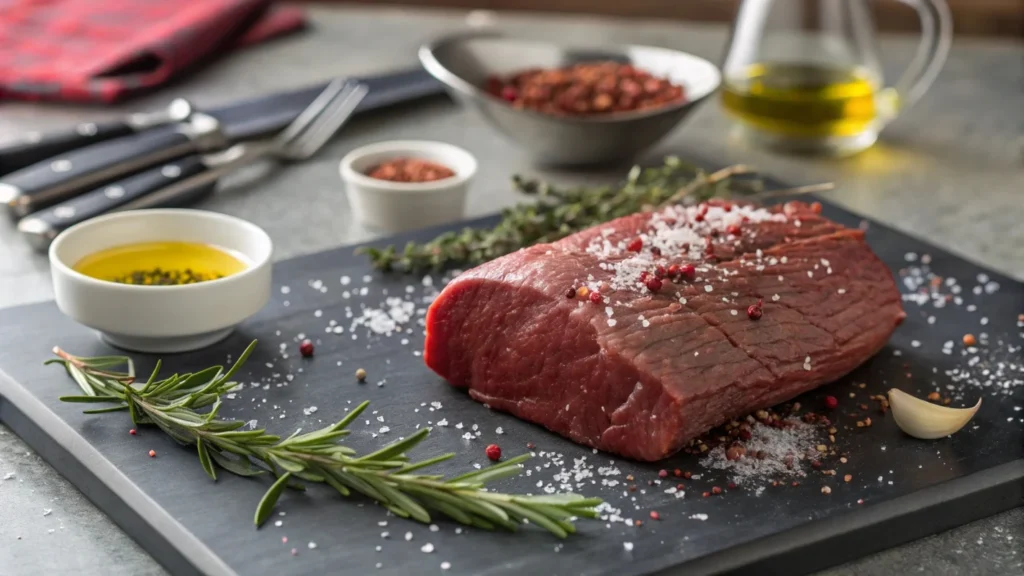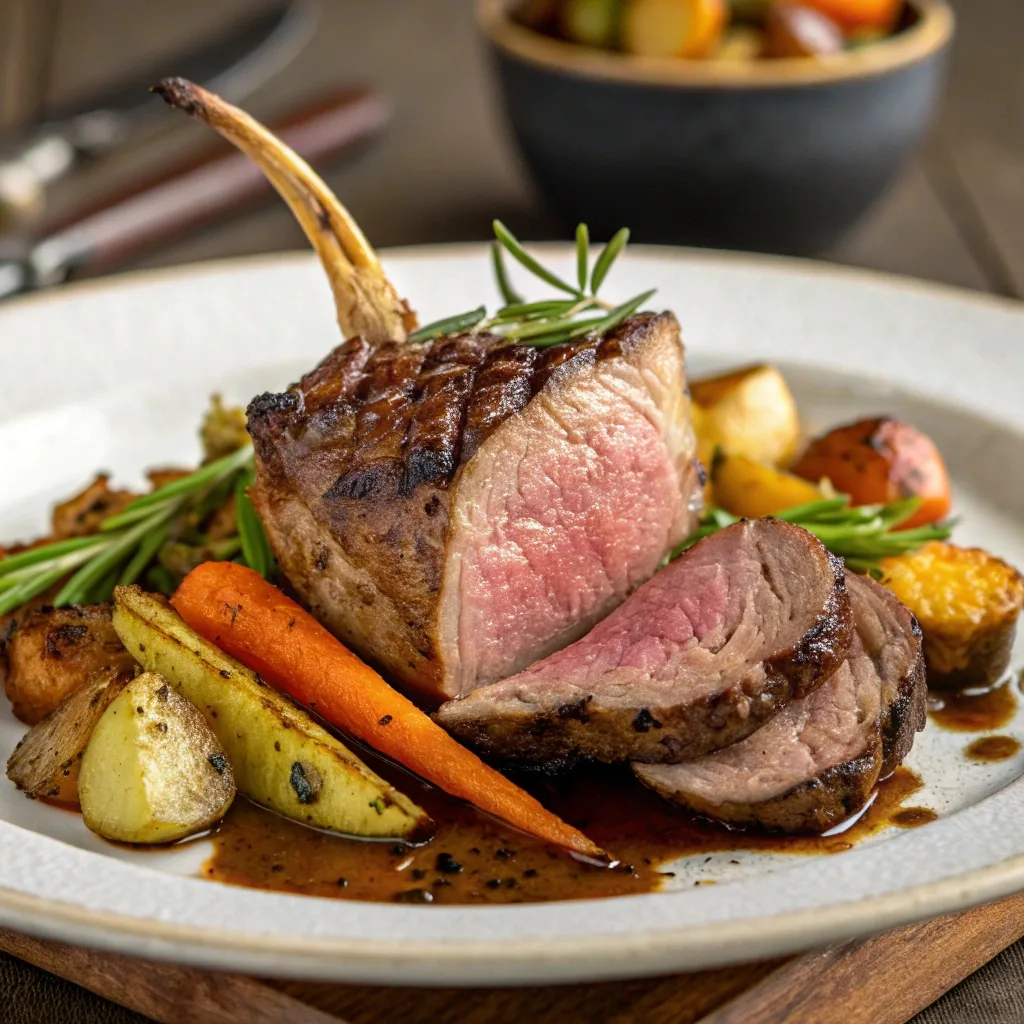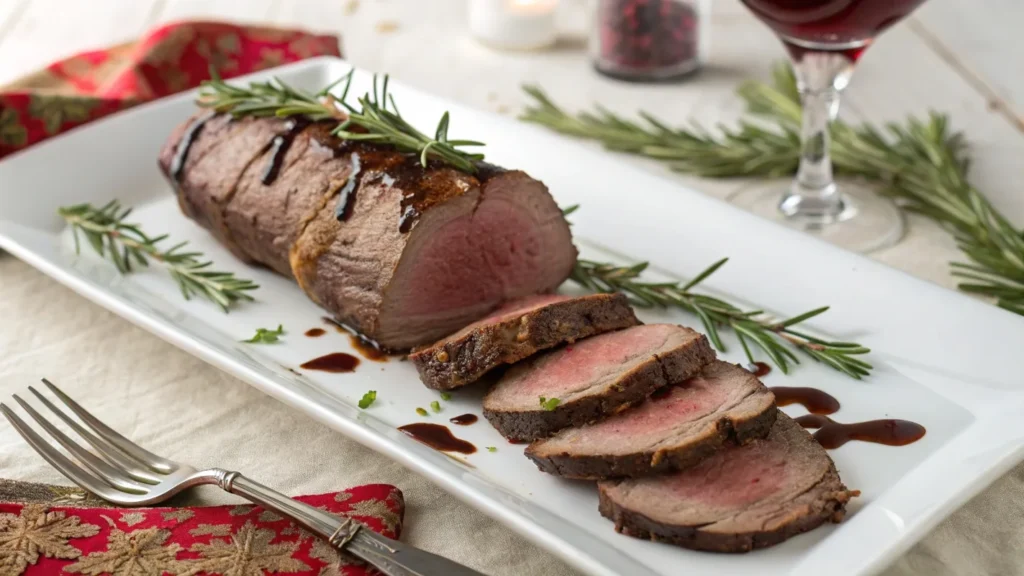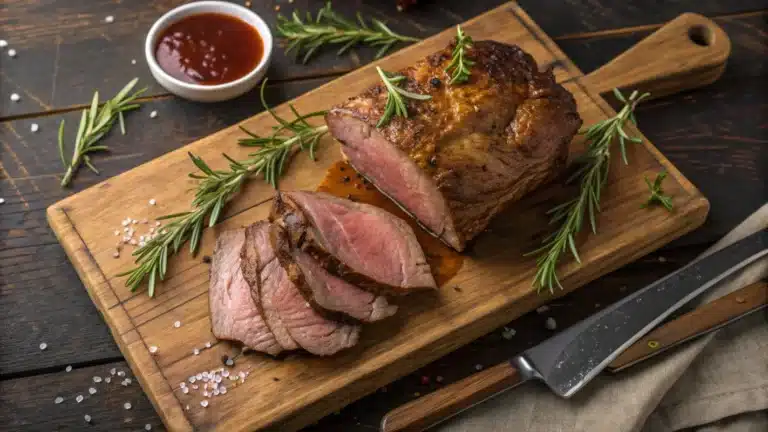Roast Venison is a lean, flavorful meat that hunters and food enthusiasts have cherished for centuries. Whether preparing a hearty roast for a special dinner or trying it for the first time, knowing how long to cook venison is key to ensuring tender, juicy results. Unlike beef or pork, venison requires a precise balance of time and temperature to highlight its unique taste and texture.
In this guide, we’ll walk you through everything you need to know about roasting venison, from ideal cooking times and temperature guidelines to preparation tips and common pitfalls to avoid. By the end, you’ll be confident to create a mouthwatering venison roast that impresses your guests and satisfies your taste buds.
Looking for inspiration? Try our Mini Pancakes Recipes for a sweet appetizer idea.
Now, let’s dive into preparing and roasting venison like a pro.
Table of Contents
- Ideal Cooking Times for Venison Roasts
- Preparing Venison for the Perfect Roast
- Temperature Guidelines for Roasting Venison
- Cooking Venison Fast vs. Slow: Pros and Cons
- Smoking Venison Roasts: A Detailed Guide
- Common Mistakes When Roasting Venison
- Step-by-Step Recipe for Roasting Venison
- FAQs
- Conclusion and Final Tips
Ideal Cooking Times for Venison Roasts
Cooking venison to perfection requires understanding how its lean composition affects roasting times. Venison lacks the marbling of fat found in beef or pork, which means it can overcook quickly. To avoid this, it’s essential to follow specific time guidelines based on the weight and cut of the meat.
General Roasting Times Based on Weight
The cooking time for a tender venison roast primarily depends on its weight. Here’s a general guide:
- 1 lb venison roast: Roast for approximately 20-25 minutes at 375°F for medium-rare.
- 2 lb venison roast: Roast for 40-50 minutes at 375°F.
- 3 lb venison roast: Roast for 60-75 minutes at the same temperature, checking frequently to prevent overcooking.
These times are for medium-rare, with an internal temperature of 135°F. Adjust the cooking time slightly if you prefer your venison medium or well-done. However, it’s best to avoid overcooking as venison can become burdensome.
Adjusting Time for Different Cuts of Venison
Different cuts of venison vary in tenderness and may require adjustments in roasting time:
- Tenderloin: This cut is incredibly tender and cooks faster. Roast for just 10-15 minutes at 375°F for medium-rare.
- Shoulder or leg roasts: These tougher cuts benefit from slower Cooking at lower temperatures, such as 325°F for 2-3 hours.
- Bone-in roasts: Add 10-15 minutes per pound, as the bone insulates the meat and slows Cooking.
Looking for inspiration? Check out our tips for a Venison Roast Recipe to take your meal to the next level.
Pro Tip: Resting Matters
Always let your venison roast rest for 10-15 minutes after removing it from the Oven. This helps the juices redistribute, ensuring a moist and flavorful result.
Preparing Venison for the Perfect Roast
Thorough preparation is essential for creating a venison roast that’s both tender and flavorful. By focusing on effective seasoning techniques and crucial pre-roast steps, you can unlock the full potential of the meat, ensuring an exquisite balance of taste and texture.
How to Properly Season and Marinate Venison
Venison’s lean nature pairs well with bold flavors, making marinades and seasonings a critical step:
- Marination Tips: Tenderize the meat with an acidic base, such as red wine, apple cider vinegar, or buttermilk.
- Add aromatic herbs like rosemary, thyme, and juniper berries for a woodsy flavor.
- Marinate for at least 4-6 hours or overnight for tougher cuts.
- Seasoning Recommendations: For a simple rub, combine salt, black pepper, garlic powder, and smoked paprika.
- Avoid overly salty marinades, as venison naturally absorbs flavors quickly.
Resting and Preparing the Meat Before Cooking
Before placing your venison in the Oven, take these steps to ensure even cooking:
- Bring to Room Temperature: Let the venison sit out for 30-60 minutes before roasting. This prevents uneven Cooking and reduces the risk of drying out the edges.
- Pat Dry for a Perfect Sear: Use paper towels to remove excess moisture from surface of the meat. This helps create a crisp, flavorful crust when seared.
- Searing the Meat: For added flavor, sear the venison in a hot skillet with a bit of oil before roasting. This locks in juices and creates a rich caramelized exterior.
Looking for a side dish to complement your venison? Don’t miss our Taco Lasagna Recipe for a unique pairing idea.
Pro Tip: The Resting Phase
Resting is just as important before cooking as after. Allowing venison to rest after applying marinades or rubs lets the flavors penetrate deeply into the meat.

Temperature Guidelines for Roasting Venison
Temperature plays a critical role in roasting venison. Due to its lean composition, venison is prone to overcooking, so it’s essential to follow precise temperature recommendations to achieve the perfect roast.
Recommended Internal Temperatures for Venison
For optimal tenderness and flavor, rely on a meat thermometer to monitor the internal temperature of your roast accurately.
- Rare: 125°F (bright red center, very juicy).
- Medium-Rare: 135°F (pink center, juicy, and tender).
- Medium: 145°F (slightly pink center, firmer texture).
- Well done: 160°F (gray center, dry texture).
Medium-rare is the ideal doneness for most venison roasts, as it keeps the meat tender while maintaining its natural flavors. Avoid going beyond 145°F, as venison tends to dry out at higher temperatures.
Tips for Using a Meat Thermometer Correctly
- Insert at the Thickest Point: Place the thermometer probe in thickest part of the roast, avoiding contact with bones or fat.
- Check While Cooking: Begin checking the temperature when the estimated cooking time is nearly up.
- Rest for Accurate Readings: After removing the roast from the Oven, the internal temperature will rise by about 5-10°F during resting.
Oven Temperature Settings for Roasting
The oven temperature also influences cooking results:
- High-heat Roasting (400°F) produces a caramelized crust but requires close monitoring to avoid overcooking. It is best for tender cuts like the loin.
- Slow Roasting (325°F) is ideal for larger or tougher cuts. It ensures even cooking and tenderizes the meat over time.
Looking for ideas on serving venison? Check out our Cream Cheese Filling Recipes for a versatile pairing option.
Pro Tip: Use a Probe Thermometer
A probe thermometer allows you to monitor the internal temperature without opening the Oven, ensuring a consistent cooking environment.
Cooking Venison Fast vs. Slow: Pros and Cons
Choosing the proper cooking method for venison can significantly impact its flavor and texture. While both fast and slow cooking methods have advantages, the best approach often depends on the cut of venison and your desired outcome.
When to Use Fast Cooking Methods
Fast cooking methods, such as roasting at high heat or pan-searing, are ideal for tender cuts of venison.
- Best Cuts for Fast Cooking: Tenderloin, backstrap, and smaller roasts.
- Advantages: Creates a caramelized crust for enhanced flavor.
- Retains juiciness in lean cuts when cooked to medium-rare.
- Quick and convenient for weeknight meals.
Example: Roast a venison tenderloin at 400°F for 10-15 minutes, aiming for an internal temperature of 135°F for medium-rare.
Benefits of Slow Cooking Venison
Slow Cooking is perfect for more arduous cuts that require tenderizing over time, such as the shoulder or leg.
- Best Cuts for Slow Cooking: Shoulder roasts, leg roasts, or bone-in cuts.
- Advantages: It breaks down connective tissues, producing a tender and flavorful roast.
- Allows for the infusion of marinades, spices, and herbs.
- Offers consistent Cooking without the risk of overcooking.
Example: Roast a venison shoulder at 325°F for 3-4 hours with vegetables and broth for a hearty dish.
How to Decide?
- Choose fast Cooking for minor, tender cuts to preserve their natural flavors.
- Allow slow Cooking for more extensive, tougher cuts to achieve fall-off-the-bone tenderness.
Looking for more tips? Learn how to make the perfect Hash brown Casserole, a hearty side dish for slow-cooked venison.
Pro Tip: Combination Cooking
For the best of both worlds, sear venison at high heat to lock in juices, then slow-roast to tenderize and develop flavor.
Smoking Venison Roasts: A Detailed Guide
Smoking venison roasts are an excellent way to enhance their flavor with a rich, smoky aroma while ensuring the meat stays tender. This cooking method requires patience but yields incredibly delicious results.
How Long to Smoke a 3 lb Venison Roast
The smoking time for venison roasts depends on the size and temperature:
- Smoking Temperature: Maintain a steady heat of 225°F.
- Estimated Time: A 3 lb venison roast typically takes about 3-4 hours to smoke, reaching an internal temperature of 135°F for medium-rare.
Monitor the internal temperature with a probe thermometer to avoid overcooking. Once the meat reaches your desired doneness, remove it from smoker and let it rest for 10-15 minutes before slicing.

Best Wood Types for Smoking Venison
The choice of wood plays a significant role in the final flavor profile of your smoked venison:
- Hickory: Strong and bold, ideal for hearty flavors.
- Applewood: Sweet and mild, perfect for delicate cuts of venison.
- Mesquite: Adds a robust, earthy flavor but should be used sparingly to avoid overpowering the meat.
- Pecan: A subtle option with a nutty, sweet undertone.
Feel free to experiment with wood combinations to create a flavor that suits your taste.
Tips for Smoking Venison
- Brining the Roast: Before smoking, brine the venison in a mixture of water, salt, sugar, and spices for 12-24 hours. This adds moisture and enhances flavor.
- Maintain Consistent Heat: Use a smoker with temperature controls or a reliable thermometer to keep the temperature steady.
- Finish with a Glaze: Brush the roast with a glaze of honey, balsamic vinegar, or barbecue sauce in the final 30 minutes of smoking for added richness.
Looking for side dishes? Try pairing smoked venison with our Peach Crumble Recipe for a unique contrast of flavors.
Pro Tip: Reverse Searing
After smoking, sear the venison on a hot grill or cast-iron skillet for 1-2 minutes per side to create a flavorful crust.
Common Mistakes When Roasting Venison
Roasting venison can be a rewarding culinary experience, but even minor mistakes can impact the flavor and texture. Avoiding these common pitfalls will help you achieve a perfectly tender and flavorful venison roast every time.
Overcooking and Drying Out the Meat
Venison is incredibly lean, which means it cooks faster than fattier meats like beef or pork. Overcooking is one of the most common mistakes.
- How to Avoid:
- Always use a meat thermometer to monitor the internal temperature.
- Remove the roast from the oven once it reaches 135°F for medium-rare and let it rest.
- Avoid cooking venison well-done, as it becomes tough and dry.
Not Resting Venison After Roasting
Skipping the resting phase is another frequent mistake. Resting allows the juices to redistribute throughout the meat, enhancing its moisture and flavor.
- How to Avoid:
- Let the venison rest for 10-15 minutes after removing it from the oven.
- Cover it loosely with foil to retain warmth while resting.
Skipping Proper Preparation Steps
Failing to prepare venison correctly can lead to uneven cooking or a lackluster flavor profile.
- How to Avoid:
- Pat the meat dry to ensure a good sear and prevent steaming.
- Marinate or season the venison to enhance its natural flavors.
- Bring the roast to room temperature before cooking to ensure even doneness.
Using the Wrong Cooking Temperature
Cooking venison at too high a temperature can result in a tough and dry roast.
- How to Avoid:
- Stick to recommended oven temperatures: 325°F for slow cooking or 375°F for a standard roast.
- Avoid fluctuating the oven’s heat by keeping the door closed during cooking.
For more tips on perfect roasting, check out our guide on Hash Brown Potato Soup Recipes.
Pro Tip: Avoid Frequent Turning
Frequent flipping or turning of the roast can lead to uneven cooking. Place the venison in the oven and let it cook undisturbed.
Step-by-Step Recipe for Roasting Venison
Creating a perfectly roasted venison dish starts with the right ingredients and following a detailed cooking process. Below is a foolproof recipe to help you achieve a tender and flavorful venison roast.
Ingredients Needed for a Venison Roast
Here’s what you’ll need to prepare a 3 lb venison roast:
- For the Roast:
- 1 venison roast (approximately 3 lbs)
- 2 tablespoons olive oil
- 2 teaspoons kosher salt
- 1 teaspoon freshly ground black pepper
- 1 teaspoon garlic powder
- 1 teaspoon smoked paprika
- Fresh rosemary and thyme sprigs (optional)
- For the Marinade (optional):
- 1 cup red wine or apple cider
- 2 tablespoons balsamic vinegar
- 1 tablespoon honey
- 2 crushed garlic cloves
Step-by-Step Cooking Instructions
- Prepare the Marinade (Optional):
- Combine the marinade ingredients in a bowl.
- Place the venison roast in a resealable bag, pour in the marinade, and refrigerate for 4-6 hours, or overnight for a deeper flavor.
- Preheat the Oven:
- Preheat your oven to 375°F for a standard roast or 325°F for a slower, more tender result.
- Season the Roast:
- Remove the venison from the marinade (if using) and pat it dry with paper towels.
- Rub the roast with olive oil, then season evenly with salt, pepper, garlic powder, and smoked paprika.
- Sear the Venison:
- Heat a skillet over medium-high heat and sear the roast on all sides for about 2-3 minutes per side until a crust forms.
- Roast the Venison:
- Transfer the seared roast to a roasting pan or oven-safe dish.
- Add sprigs of rosemary and thyme for added aroma.
- Cook to Desired Doneness:
- Roast in the oven until the internal temperature reaches 135°F for medium-rare (about 60-75 minutes for a 3 lb roast).
- Rest the Roast:
- Remove the venison from the oven and let it rest for 10-15 minutes before slicing.
- Serve and Enjoy:
- Slice the roast thinly and serve with sides like Air Fryer Sweet Potato Cubes for a hearty meal.

FAQs
Answering common questions about roasting venison ensures you’re equipped with the knowledge to create a perfect roast every time. Below, we address frequently asked queries to help you become a venison expert.
1. How Long Does It Take to Roast Venison?
The cooking time depends on the weight and desired doneness:
A 1 lb venison roast takes approximately 20-25 minutes at 375°F for medium-rare.
A 2 lb roast requires 40-50 minutes, while a 3 lb roast takes 60-75 minutes.
Always use a meat thermometer to confirm the internal temperature for precision.
2. How Long Does It Take to Cook Deer in the Oven?
Cooking venison in the oven depends on the cut and method:
Fast roasting: 375°F for 20-25 minutes per pound.
Slow roasting: 325°F for 2-3 hours, suitable for tougher cuts like the shoulder or leg.
3. How Long Does It Take to Cook a Pound of Venison?
On average, a pound of venison takes 20-25 minutes at 375°F. However, this can vary based on the oven, cut, and doneness preference.
4. What Temperature Should Venison Be Cooked At?
For the best results, follow these temperature guidelines:
Rare: 125°F
Medium-rare: 135°F
Medium: 145°F
Avoid exceeding 145°F, as venison can dry out quickly.
5. Is It Better to Cook Venison Fast or Slow?
The best cooking method depends on the cut:
Fast Cooking: Ideal for tender cuts like tenderloin or backstrap. High heat sears the exterior and locks in juices.
Slow Cooking: Best for tougher cuts like the shoulder or leg, as it tenderizes the meat over time.
6. How Long to Smoke a 3 lb Venison Roast?
Smoking a 3 lb venison roast at 225°F takes 3-4 hours to reach medium-rare. Remember to use a meat thermometer and let the roast rest after smoking.
Looking for venison-friendly pairings? Discover our Blackened Chicken Alfredo Recipe for a creamy side option.
Pro Tip: Rest and Reheat
To retain moisture, rest venison after cooking and reheat gently if needed.
Conclusion and Final Tips
Roasting venison is an art that combines patience, precision, and the right techniques. By understanding the importance of time, temperature, and preparation, you can create a delicious, tender venison roast that highlights the meat’s rich, natural flavor.
Key Takeaways
- Always use a meat thermometer to monitor the internal temperature, aiming for 135°F for medium-rare.
- Choose the right cooking method: fast roasting for tender cuts and slow roasting for tougher ones.
- Preparation is key—marinate for added flavor, sear for a crusty exterior, and always let the meat rest before slicing.
Final Tips for Success
- Experiment with flavors: Venison pairs well with bold marinades, herbs, and spices.
- Don’t rush: Allow the roast to rest after cooking for juicier results.
- Plan your sides: Pair your roast with hearty sides like Hash Brown Potato Soup or Garlic Parmesan Chicken Pasta.
Elevate Your Venison Cooking
Mastering venison roasting opens up a world of culinary possibilities. Whether you’re hosting a dinner party or enjoying a quiet meal, a well-prepared venison roast is sure to impress.
For more tips and recipes, explore our Venison Roast Guide for step-by-step advice.

